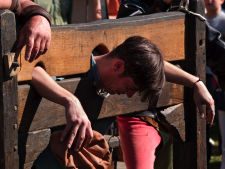 PILLORY
PILLORY  TARRING
TARRING“The Bostonians paying the excise-man, or tarring and feathering.”
A 1774 British print depicted the tarring and feathering of Boston Commissioner of Customs John Malcolm. Tarring and feathering was a ritual of humiliation and public warning that stopped just short of serious injury. Victims included British officials such as Malcolm and American merchants who violated non-importation by importing British goods. Other forms of public humiliation included daubing victims’ homes with the contents of cesspits, or actual violence against property, such as the burning of stately homes and carriages. This anti-Patriot print showed Customs Commissioner Malcolm being attacked under the Liberty Tree by several Patriots, including a leather-aproned artisan, while the Boston Tea Party occurred in the background. In fact,
Shameful exposure
The offender could alternatively be sentenced to remain exposed in a specific public place, in a restraining device.
In the more extreme cases being subjected to verbal and physical abuse from the crowd, which could have serious consequences especially when the hands are not free to protect himself. Some sentences actually prescribe additional humilitation, such as shaving, or combine it with painful corporal punishments
The humiliation is generally intensified if the victim is unclothed (either partially or completely) as the exposure leaves the victim feeling vulnerable and helpless.
Even when not strictly public, humiliation can still be a psychologically "painful" aspect of punishment because of the presence of witnessing peers (such as fellow prisoners), relatives, staff or other onlookers, or simply because the tormentor witnesses how self-control is broken down. This is also true for punishments in class.

No comments:
Post a Comment